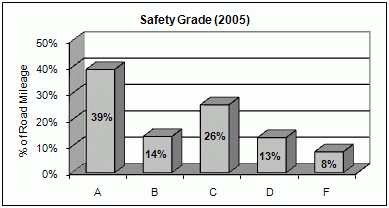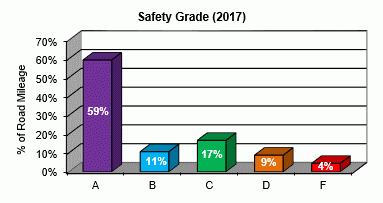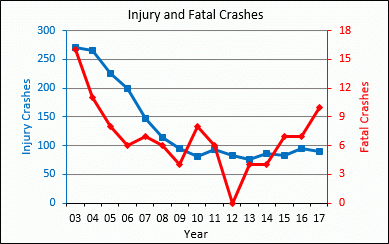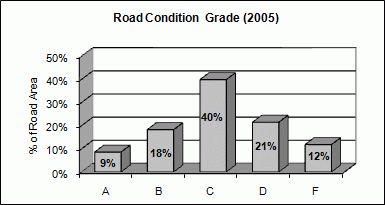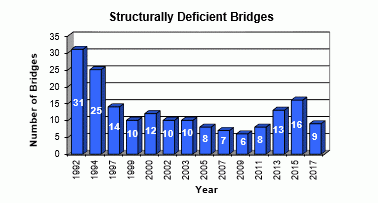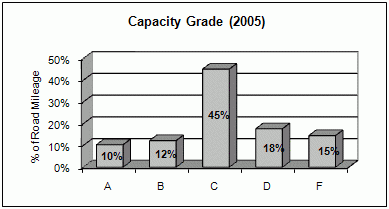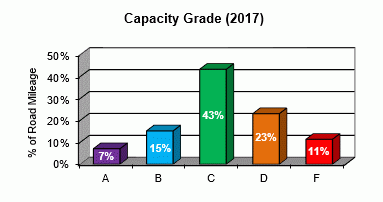Highlighted Performance Measure
Crash Rate. This rate is the number of reported crashes relative to the volume of traffic on the road. The crash rate is expressed as the total number of reported crashes divided by the total number of vehicle miles traveled over that road in a given year.
Safety Grade Maps
Why is this important?
Across the nation, rural two-lane roadways have consistently been found to be the most dangerous part of the public road system. While a greater number of crashes may occur on state highways or city streets, these state highways and city streets carry much higher volumes of traffic. The rate of crashes - the number of crashes relative to the volume of traffic - is highest on rural two-lane roadways. This means that there is a greater chance that a driver will be involved in an crash driving on a rural county road compared to driving on a state highway or city street.
What are we doing about this?
Knowing which roads have the highest crash rates allows County staff to focus on those particular roads. In looking at the causes of these crashes, we can determine whether improvements can be made to improve safety on the road such as straightening a sharp curve, widening shoulders, removing obstacles along the roadway, installing guardrail, etc. While we know we cannot eliminate all crashes, our goal is to make the County road system as safe as possible, given the funds we have available for safety improvements.
Highlighted Performance Measure
Road Condition Index. The condition index is based on a physical inspection of the road, measuring surface distresses such as washboarding, rutting, cracking and potholes. Every road is physically inspected at least once every three years.
Condition Grade Maps
Why is this important?
Poorly maintained roads cost drivers money by increasing the wear and tear on vehicles. Poor road conditions may also contribute to an increase in crashes. Research has clearly shown that early preventive maintenance, particularly on paved roads, costs only a fraction of later, more extensive repair or reconstruction.
What are we doing about this?
By monitoring road conditions carefully, County staff tries to provide cost effective, preventive maintenance at just the right time. This allows us to stretch limited road maintenance dollars as far as possible. Over the past half dozen years, the cost of road maintenance (particularly the cost of equipment, fuel and asphalt products) has increased dramatically while the level of funding for road maintenance has remained relatively flat. As a result, the overall condition of the road system (the cumulative grade point average or GPA) has been declining. We are looking at ways to improve the efficiency of our road maintenance efforts as well as ways to increase the amount of funds available for road maintenance.
Larimer County uses bridge structure inspection data from the National Bridge Inspection Program to prioritize bridges for repair, rehabilitation and replacement. The objective of this program is to repair, rehabilitate and replace as many bridges as possible with the funds that are available. A major criteria used for prioritization is whether a bridge is structurally deficient. The adjacent graph depicts the number of structurally deficient major bridges and culverts in Larimer County beginning in 1992, when the county began receiving the inspection data.
Highlighted Performance Measure
Volume to Capacity Ratio (V/C). This ratio compares the amount of traffic a road is actually carrying to the amount it can theoretically carry at an acceptable level of service. Actual traffic volumes on county roads are measured in the field at least once every three years.
Capacity Grade Maps
Why is this important?
The Volume to Capacity Ratio (V/C) is an indicator of the likelihood that a road might be improved in the future. For example, if the current traffic is close to or exceeds the theoretical capacity (corresponding to grades of D or F), the road may need to be improved to increase that theoretical capacity. For a gravel road, the improvement may be paving the surface. For a paved road, the improvement may be increasing the width of the travel lanes or shoulders. In a very few cases, the improvement may consist of enlarging a paved road from two to four travel lanes.
What are we doing about this?
County staff uses this information about road capacity to determine what road improvements should be required of developers who increase traffic volumes by creating new homes or businesses in the unincorporated area. Staff also uses the information to plan the County's capital improvement program (CIP). Currently, the need for capacity improvements far exceeds the amount of funds available, so we focus on what we consider to be the highest priority capital improvement needs. This process of prioritizing projects looks at safety and maintenance needs as well as traffic capacity.
